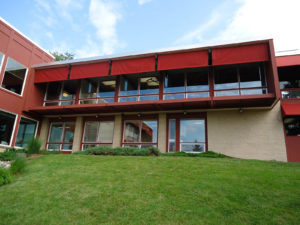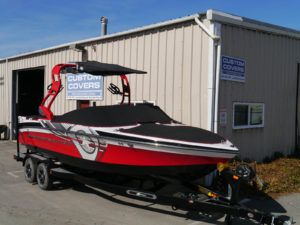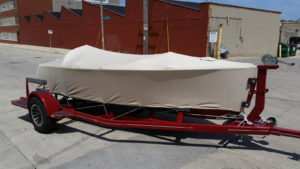
Understanding the customer’s unique wants and requirements goes to the heart of successful custom projects.
Larry Schneider, owner of Homestyle Awning & Upholstery in Bay View, Wis., recently worked on a project that seemed fairly simple—adding screens to a car trailer so the customer could sleep in it. After talking it through with the customer, Schneider discovered he wasn’t looking for anything simple.
“All of a sudden he wanted a door; then a magnetic door with a zipper. As we talked, it kept progressing and we were working out the design,” he says. “It always starts out, ‘Oh, this should be simple; it won’t take you any time at all.’ Then it’s ‘How am I going to make it do this trick?’”
Estimating custom jobs gets complicated because each one is unique. A long-term fabricator, Schneider relies on his knowledge and past experiences. What he has come to understand is how to get to the heart of the customer’s needs, wants and expectations. “It always starts with the customer. If they don’t know what they want, at least find out what they need; what they want the product or the service to do for them. Then you can give them some options.”
Take time, do it right
Accurate job costing takes time for a profit to be realized. For this reason, Dawn Taylor, MFC, from the Marine Canvas Training Institute in Palmetto, Fla., teaches apprentices to make a checklist of all the things that need to go into the job, and never give an estimate over the phone even if it is something they’ve done before.
“We always go look at the (customer’s) job first because a lot of times, what they’re telling us is not everything,” says Taylor. “Sometimes we have to check how we can get access to the boat; for instance, if it’s on a boat lift on the water. We can’t walk on water. It may have to be put on a float. Often they don’t tell us if it’s an open boat or a T-top.”

Taylor says they try not to have unexpected issues come up, but when they do, they have to work around them. “Because we’ve gone to look at the boat, we don’t change our estimate unless the customer makes the change. If we made a mistake and had to put in more time, that’s our problem.”
Especially with commercial projects, it’s important to take the time to think of every conceivable thing that could present a challenge, notes Kathy Schaefer, IFM, COO, Glawe Awning & Tent Co. in Fairborn, Ohio. The company does a site survey and photographs the surrounding area when meeting the customer.
“Noting the mounting surface and the logistics of set-up ahead of time precludes not having the correct hardware or taking the wrong vehicle to the site,” Schaefer says. “We have experienced construction site locations where all materials must be hand carried to the installation site. By determining this ahead of time, extra labor and time can be built into the quote.”
Having a photo of the site was useful on a recent new construction install. When crews arrived to put up the completed project, there was a large downspout right in the middle of the awning location. The client had approved the contract with the picture attached to it, so he was responsible for the additional costs incurred to modify the cover and frame.
Schaefer adds that the true cost of any project involves the operating costs of the facility where it is made and the materials and labor to produce it. “When we determine the overhead and administrative percentages, they are quite substantial. To not use this as a factor when determining cost is lying to yourself.”
Labor costs are complex
While material costs can be predictable, labor costs can be a tricky proposition in some cases. Lessons learned from the past help address some of these issues, says Carl Pelligrini, owner of Sea Canvas in Egg Harbor Township, N.J. An upholstery interior, for example, may require the need to break down some interior parts, such as wood trim or hardware, to get into an area to be finished. Approximate time needs to be assessed with a reasonable open end for these types of issues.

“Discussing and including this time adjustment with the customer needs to happen and [needs to be] included in a contract or estimate. Most exterior work, such as bending new framework and creating an enclosure, is straightforward. The worst we would run into there is setting new fittings in the fiberglass that needs work.”
Look at it as a learning lesson if the hours add up more than your quote, Pelligrini adds. “We’re selling custom creations and getting every job spot on in an estimate is just not realistic. We at times will spend more time than estimated on a job, but the final product will shine, the client will be thrilled and another lesson should be learned from the experience.”
Labor costs need to take into account where the job site is and how many people are needed at the site, says Andy Moon, CEO of Baraboo Awning in Baraboo, Wis. Things like hotels and travel costs for overnight stays and per diem costs must be included in estimating a project.
“The location of the job is key. How close can we park our truck to the actual site, how high in the air are we going? Safety adds dollars. Do we need to rent a lift, have extension ladders or cranes?” Moon says his company is always looking for new equipment that can help lower labor costs.
Purchasing equipment has helped Schaefer with profitability on certain jobs. She will order equipment to assist with an install rather than send more installers or spend more time moving ladders. “I found that I was renting a scissor lift so often, I ultimately purchased a used one from our rental company. Using our lift on higher jobs not only saves time, but also is much safer than using a ladder and balancing an awning.”
Estimates must also reflect higher costs for seasonal work, such as in boating and marine. Some fabricators promote lower prices during the non-busy season to get projects done early before the heavy season begins.
The wild card factor
Wild cards like job-site access or unexpected delays to get the job done right will all factor into the cost. Often a business is not able to recoup the losses. In Moon’s experience, for example, measuring errors occur too often. “All dollars from errors seem like they’re coming right out of my pocket and affecting the bottom line,” he says.
Things like an unexpected extra trip to the boat, or a flaw in some part of the materials used that wasn’t caught in advance can add unanticipated time to the overall job, says Chandler Clark of Signature CanvasMakers in Hampton, Va. “Unforeseen circumstances are a cost of doing business, and should be accounted for in the big picture of pricing,” he says. “We do not go back and charge the customer extra for a mistake on our part.”
Weather delays are one of those unforeseen events. Lightning and storms can delay a crew for hours and sitting idle in a truck can eat into profits, yet this is difficult to predict. Schaefer uses weather apps to make a determination of whether to wait it out or have the crew come home.
Schaefer has also experienced a larger percentage of jobs requiring permits and engineering. This cost is so variable for each municipality that it is added as a separate line item on the contract to be determined when the cost is known.
Pelligrini advises that keeping notes from past jobs is a good start in addressing unusual factors: “Every estimate has a bit of a ‘wild card’ factor involved. Thinking through every step of a job is critical. Experience is key to eliminating such quoting issues.”
Adopting new technologies
New technological advances in the industry give some companies an edge in a competitive market, but not all shops can absorb the cost of the equipment. Some companies have adopted smaller technologies to save time and estimating, such as mobile-enabled devices to print or send invoices onsite. Glawe Awning & Tent has installed GPS units in all their vehicles to keep track of their crew locations. This is helpful when one crew needs help on a particular job that was unforeseen.
“One technology advance that would save quite a bit of time would be a computer program for permitting,” says Schaefer. “Filling this out online and applying for the permit would be streamlined and companies would know the basic criteria for the process. With the widespread use of the Internet, it is frustrating that we still must send someone in person to apply for permits.”
Fabricators also say they’d like to see new software programs that can accomplish different things. Clark uses QuickBooks™ accounting software, but is exploring the availability of a mobile-enabled program that can integrate the accounting with Customer Relationship Management (CRM) and Project Management software.
But new technologies will never replace in-person customer relations, Pelligrini says. “Technology is changing how our industry produces a final product, but has not changed an old fashioned face-to-face meeting with a potential client. It is an important 20 minutes to build a relationship and confidence with that customer.”
Barb Ernster is a freelance writer based in Fridley, Minn.
With the lack of standard estimating software on the market, many companies rely on QuickBooks™ or a well-developed Excel™ spreadsheet to create their estimates. Not finding anything on the market to help streamline this process, Justin Jones, owner of Custom Covers in Salt Lake City, Utah, developed his own software database system built on a FileMaker platform to help understand the real costs of his projects. He has been improving on the system for six years, and is hoping to sell it soon to other shops.
The program can be used on an iPad at a job site where a photo can be taken, and specific details, such as colors and time allowances for unique circumstances, entered into a template. Then it can be emailed to the customer with a photo of the customer’s project or sample photos of previous work.
Estimates can be generated easily by anyone on the staff in five or 10 minutes, as opposed to taking hours. Moreover, it automatically reflects updates on cost of materials, which are always changing. “I think that’s one reason many shops sell their products below market value. They don’t realize how much the materials actually cost them,” Jones says.
“I know many shops are focusing on the cool CAD and cutting technology, and we want that too, but over the last six years we chose to focus on our software to help make the best of what we already have and do,” he adds. “The real benefit has come by being able to see what various projects cost to produce, and it reinforces what we should be charging. Now we can confidently give budget numbers. The more confident and casual we are about the cost of things, the less resistance we get from the customer.”
With the help of her accountant, COO Kathy Schaefer designed a program for Glawe Awning & Tent Co. utilizing Microsoft Excel for job costing after the fact and job estimating prior to the sale. Using quarterly profit and loss statements, employees assign each item to direct costs, overhead, selling and administrative costs. The numbers represent the real-time expenses the company is incurring, and are used to determine percentages based on the ratio of costs to sales in each department, which are used to estimate jobs accurately.
The program lists all the direct materials and their costs, adding a small percentage for findings, and combines that with the labor costs for each area of the job, drawn from a chart of job classifications. The total comprises the prime costs. They then determine the estimated overhead cost
and selling/admin cost using the percentages from the quarterly report.
“This process will tell us the true cost of the job so that we can determine our profit margin based on good numbers,” says Schaefer.
MFA Time Standards Manual
The Marine Fabricators Association (MFA) has a Time Standards Manual (TSM) available to members that can be a big help for estimating marine jobs, especially for newcomers to the field. It provides a detailed checklist of time standards for every part of a project and can provide quick assistance with validating estimates.
As they gain experience, marine fabricators can add or reduce time for certain areas and get a better handle on making profits, says Dawn Taylor of the Marine Canvas Training Institute in Palmetto, Fla. “The time standards are a good way to tell if you’re making any progress. As you get better, you’re doing things quicker than what the time standards tell you and you’ll be making more money.”
Because of regional differences in the language used by fabricators to define a project, the Time Standards committee is working on a glossary of terms to describe these differences, such as a “U-zip window” versus a “Smile window.”
Committee member Larry Schneider says, “I think it’s good that we’re making a glossary of terms so everybody is talking about the same things; everybody will have a better understanding of the finer points.”
The Professional Awning Manufacturers Association (PAMA) will also have a Time Standards Manual, which it hopes to have available to members on the PAMA website sometime this fall.
 TEXTILES.ORG
TEXTILES.ORG



2 responses to “Estimating for profit: Where to begin”